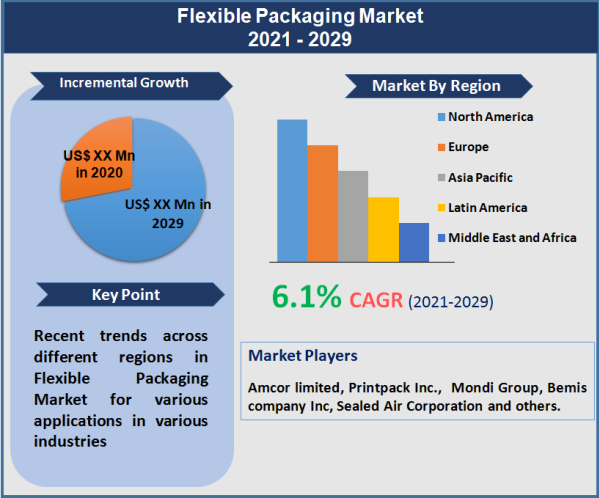Packaging of the products is one of the most vital components in many sectors including fast moving consumer goods, food and beverages, pharmaceutical and others. Packaging protects and preserves the product from damage, and at the same time act as a crucial marketing and communication tool for the business. Flexible plastic packaging refers to the use of plastic material including polypropylene (PP), polyethylene (PE), and polyethylene terephthalate (PET) etc. to create non-rigid plastic structures whose shape can readily be changed. The technologies that shaped the modern flexible plastic packaging dates to 1690 when the first paper mill was established in the US.
Global flexible plastic packaging market is estimated to grow at a CAGR of 6.1% during forecast period (2021-2029). Global flexible plastic packaging market is primarily driven by cost effectiveness & increased shelf-life and rising demand from end-users. According to the Flexible Packaging Association (FPA) (US), as compared to other types of packaging, flexible packaging can save cost up to 10 times thus, enables increased product yields by reducing content waste by 50-90%. Furthermore, as per Industry Council for Research and Packaging on the Environment (INCPEN), flexible plastic packaging reduced the wastage of food from 3-1% by extending the shelf-life of products such as dairy, vegetables, etc. Moreover, increasing demand for fresh food is propelling the adoption of flexible plastic packaging across the globe. As per a study by United States Environmental Protection Agency (US EPA), flexible plastic bags produce 80% less solid waste than paper and other materials and consume 40% less energy to produce. In addition, the study also stated that a pound of plastic takes 91% lesser energy to recycle as compared to a pound of paper and other materials, making flexible plastic packaging materials more cost effective than other conventional packaging materials such as paper coupled with other advantages offered by them such as increased food shelf life, downsizing of packaging, lightweight and durability. Covid 19 led lock downs had significant adverse impact on the market due to interruption in production and logistics. The report covers the impact of the pandemic in-depth.

Global flexible plastic packaging market has been segmented on the basis of type, printing technology and application. The application segment is further sub-segmented into food & beverages, cosmetics & toiletries, healthcare and others. Food & Beverages leads the application segment in terms of revenue in the global flexible plastic packaging market with around 58% market share in terms of revenue 2020. Adoption of flexible plastic packaging is rising in food and beverage industry owing to cost-effectiveness and other benefits offered by flexible plastics. The growing demand for food across the globe primarily due to rising population coupled with increased demand for packaged food is expected to drive the demand for flexible plastic packaging in food and beverages segment.
Geographically, the global flexible plastic packaging market has been segmented into North America, Europe, Asia Pacific and Rest of World (ROW). Asia Pacific leads the global flexible plastic packaging market by capturing largest market share in terms of revenue of around 40% in 2020. Flexible plastic packaging market in Asia Pacific is primarily driven by dominant position of Asia Pacific in plastic production, high investment to set up flexible packaging production plants coupled with growth in food and beverage market. Countries of Asia accounted for approximately 50% of the world plastic production in 2019. High plastic production results in high demand of plastics from fast moving consumer goods, food and beverages, pharmaceutical and other sectors.
Merger and acquisition is the primary strategy adopted by companies in the global flexible plastic packaging market. The companies increase their dominance and market share by acquiring other companies to increase their product portfolio. The top companies include Amcor limited, Printpack Inc., Mondi Group, Bemis company Inc, Sealed Air Corporation and others.
Historical & Forecast Period
This study report represents analysis of each segment from 2023 to 2033 considering 2024 as the base year. Compounded Annual Growth Rate (CAGR) for each of the respective segments estimated for the forecast period of 2025 to 2033.
The current report comprises of quantitative market estimations for each micro market for every geographical region and qualitative market analysis such as micro and macro environment analysis, market trends, competitive intelligence, segment analysis, porters five force model, top winning strategies, top investment markets, emerging trends and technological analysis, case studies, strategic conclusions and recommendations and other key market insights.
Research Methodology
The complete research study was conducted in three phases, namely: secondary research, primary research, and expert panel review. key data point that enables the estimation of Flexible Packaging market are as follows:
Market forecast was performed through proprietary software that analyzes various qualitative and quantitative factors. Growth rate and CAGR were estimated through intensive secondary and primary research. Data triangulation across various data points provides accuracy across various analyzed market segments in the report. Application of both top down and bottom-up approach for validation of market estimation assures logical, methodical and mathematical consistency of the quantitative data.
| ATTRIBUTE | DETAILS |
|---|---|
| Research Period | 2023-2033 |
| Base Year | 2024 |
| Forecast Period | 2025-2033 |
| Historical Year | 2023 |
| Unit | USD Million |
| Segmentation | |
Type
| |
End-use Industry
| |
Application
| |
|
Region Segment (2023-2033; US$ Million)
|
Key questions answered in this report